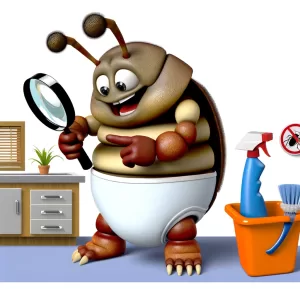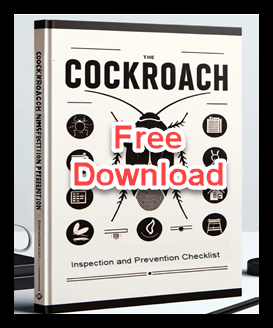Baby Palmetto Bug: Identification and Control
 If you’ve encountered small, fast-moving insects in your home and are wondering if they might be baby palmetto bugs, you’re not alone. Understanding what baby palmetto bugs look like and how to deal with them is crucial for preventing a full-blown infestation. In this article, we’ll explore the life cycle of palmetto bugs, how to identify their nymphs, and effective methods to control and prevent these unwelcome pests.
If you’ve encountered small, fast-moving insects in your home and are wondering if they might be baby palmetto bugs, you’re not alone. Understanding what baby palmetto bugs look like and how to deal with them is crucial for preventing a full-blown infestation. In this article, we’ll explore the life cycle of palmetto bugs, how to identify their nymphs, and effective methods to control and prevent these unwelcome pests.
Life Cycle of Palmetto Bugs
Egg Stage Palmetto bugs, also known as American cockroaches, lay eggs in a protective case called an ootheca. Each ootheca can contain up to 16 eggs and is usually deposited in hidden, moist areas where the eggs can safely develop.
Nymph Stage When the eggs hatch, the young cockroaches, known as nymphs, emerge. These nymphs are often referred to as baby palmetto bugs. They undergo several molts as they grow, gradually developing into adults. The nymph stage can last several months, depending on environmental conditions.
Adult Stage After multiple molts, the nymphs mature into adult palmetto bugs. Adults can live for over a year, continuing the cycle by laying new eggs and perpetuating the infestation.
Identifying Baby Palmetto Bugs
Appearance
- Size: Nymphs are significantly smaller than adult palmetto bugs, typically measuring between 4 to 6 mm when they first hatch.
- Color: Young nymphs are usually white or light gray immediately after molting but darken to a reddish-brown color as they mature.
- Shape: Baby palmetto bugs have a similar body shape to adults but are smaller and lack fully developed wings.
Behavior
- Hiding Spots: Nymphs prefer dark, moist environments. Common hiding spots include under sinks, behind appliances, and in bathroom cabinets.
- Movement: Nymphs are fast and can quickly scurry away when disturbed, making them difficult to catch.
Preventing and Controlling Baby Palmetto Bugs
Sanitation
- Keep It Clean: Regularly clean kitchens and bathrooms to remove food crumbs and spills that can attract palmetto bugs.
- Proper Food Storage: Store food in sealed containers and promptly dispose of garbage to eliminate potential food sources.
Moisture Control
- Fix Leaks: Repair any leaky faucets or pipes to reduce the moisture that palmetto bugs need to thrive.
- Use Dehumidifiers: In particularly damp areas, use dehumidifiers to lower humidity levels.
Sealing Entry Points
- Caulk Cracks and Gaps: Inspect your home for cracks and gaps, especially around doors, windows, and the foundation. Seal these entry points to prevent nymphs from getting inside.
- Install Screens: Ensure that windows and vents have tight-fitting screens to keep palmetto bugs out.
Baits and Insecticides
- Baits: Use cockroach baits in areas where you have seen nymphs. Baits are effective because they attract and poison the bugs.
- Insecticides: Apply insecticidal sprays or dusts in cracks, crevices, and other areas where nymphs are likely to hide. Follow all safety instructions on the product label.
Professional Pest Control For severe infestations, it may be necessary to call in professional pest control services. Professionals can conduct thorough inspections, use specialized treatments, and provide ongoing monitoring to ensure the infestation is fully eradicated.
Conclusion
Identifying and controlling baby palmetto bugs is a critical step in preventing a larger infestation. By understanding their life cycle, recognizing the signs of nymph activity, and implementing effective control measures, you can keep your home free of these pests. Regular cleaning, moisture control, and sealing entry points are essential practices to maintain a pest-free environment.
Call to Action
Stay proactive in your efforts to control palmetto bugs. Regularly inspect your home, maintain cleanliness, and use appropriate pest control methods. If the infestation persists, don’t hesitate to seek professional help to ensure a thorough and effective solution.
- The Life Span of a Cockroach
- Do Cockroaches Eat Clothes?
- Do Cockroaches Have Teeth?
- Shrimps and Cockroaches
- Will Sleeping with the Light On Keep Cockroaches Away?
- How to get roaches out of your car overnight
- Do Cockroaches Feel Pain?
- How Many Legs Do Cockroaches Have?
- Comparing Cockroach Eggs Size for Different Types of Cockroaches
- Identifying a Cockroach Bite on the Lips or Face
- Black Water Bug Identification and Control
- Why Do Water Bugs Come Out At Night?
- What Does Roach Rash Look Like?
- Can Cockroaches Bite Your Eyelid?
- Can Cockroaches Live in Your Balls?
- How did cockroaches get their name?
- Why Do Cockroaches Shed Their Skin?
- What Smell do Palmetto Bugs Hate?
- Baby Palmetto Bug: Identification and Control
- Cockroach Eggs vs Poop: How to Tell the Difference
- How to Get Rid of Water Bugs
- How Long Can a Cockroach Live Without Air?
- The Lifecycle of the German Cockroach: From Egg to Adult
- Do Mice Eat Roaches
- Wood Roach vs. Cockroach

